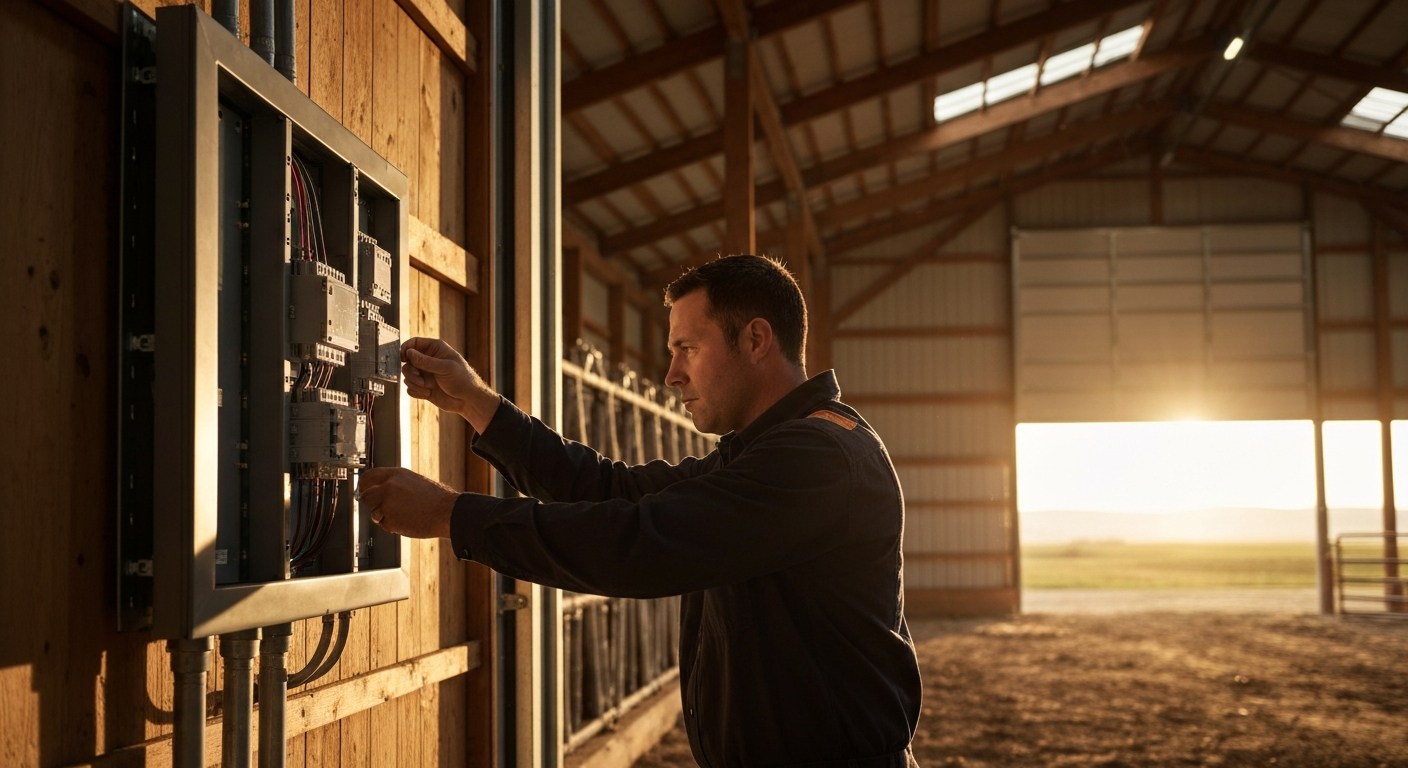
Electrical Work in Agricultural Buildings: A Montana Guide
The Unique Demands of Farmstead Wiring
Wiring an agricultural building isn’t just a matter of pulling wire and installing outlets. These environments are uniquely hostile to electrical systems. Electricians must contend with dust from grain and hay, high humidity, and, most notably, a severely corrosive atmosphere that electrical systems must be built to withstand. Ammonia from animal waste and chemicals used for cleaning can degrade standard electrical components with surprising speed, creating serious safety hazards. This is one reason why safety is paramount; in 2022, Montana’s agriculture, forestry, fishing, and hunting sector experienced six fatal work injuries, a stark reminder of the risks involved.
Beyond corrosion, electricians face challenges from:
- Moisture: Constant exposure from pressure washing, condensation, and animal respiration requires watertight and corrosion-resistant enclosures and wiring methods.
- Pests: Rodents can chew through standard cable jackets, leading to shorts and fire hazards.
- Physical Damage: The risk of damage from livestock and heavy machinery is always present, demanding robust and well-protected installations.
Mastering NEC Article 547: Your Rulebook for Agricultural Buildings
Given these challenges, the National Electrical Code dedicates a specific section to this work: NEC Article 547, Agricultural Buildings. This article is the definitive guide for ensuring safety and durability in farmstead wiring. It’s not just a set of recommendations; it’s the code-mandated standard for any structure that houses livestock, poultry, or agricultural products. Understanding its core principles is non-negotiable for anyone working in livestock confinement facilities or other farm structures.
Wiring Methods and Materials
Article 547 places heavy emphasis on choosing the right materials. While EMT conduit might be a go-to in commercial jobs, its use is often restricted in areas with corrosive atmospheres. Instead, the code points toward non-metallic solutions. A proper UF cable installation (Underground Feeder) or, more commonly, Type NMC cable (Nonmetallic Sheathed Cable, Corrosion Resistant) is often required. These cables feature jackets designed to withstand moisture, fungus, and corrosion, making them ideal for agricultural building wiring.
The Critical Role of GFCI Protection
Nowhere is shock protection more critical than in damp, conductive agricultural settings. GFCI protection agricultural rules are stringent for this reason. According to the 2023 NEC 547.25, GFCI protection is required for all 125-volt, single-phase, 15- and 20-ampere receptacles in locations like areas with an equipotential plane, outdoors, damp or wet locations, and dirt confinement areas for livestock. Whether you use a GFCI breaker at the panel or a GFCI outlet at the point of use, ensuring every required receptacle is protected is a life-saving measure. These requirements often go beyond those for typical commercial buildings; you can learn more about where the 2023 NEC requires GFCI in non-dwellings to see how these specialized environments differ.
Equipotential Planes and Stray Voltage
One of the most unique and critical concepts in agricultural wiring is the equipotential plane, a requirement detailed in 2023 NEC 547.10. In areas where livestock are confined, small differences in electrical potential (stray voltage) can flow through the concrete, metal grates, and the animals themselves. This can cause behavioral issues, reduced production, and is inhumane. Equipotential plane bonding involves connecting all metallic surfaces within the plane—stalls, waterers, and the concrete’s rebar—to the building’s grounding system. This creates a zone of equal potential, eliminating dangerous current paths. Proper agricultural electrical grounding is fundamental, and regular stray voltage testing is a key service electricians can offer to farm clients. For a deeper dive into the principles at play, understanding the difference between bonding vs. grounding as required by the NEC is essential.
Specialized Systems on the Modern Montana Farm
The scope of agricultural electrical work Montana electricians encounter is growing. As farms modernize, several specialized systems have become commonplace.
- Irrigation Systems: The miles of wire needed for center pivot irrigation wiring require careful planning for voltage drop and physical protection, as specified in 2023 NEC Article 675. A key safety component for these systems is a site-isolating device, which provides a clear, lockable point of disconnection for maintenance.
- Water Systems: Reliable power for stock water well pumps is a lifeline for any ranch. These installations must be robust enough to handle the harsh Montana climate year-round.
- Renewable Energy: According to 2023 data from the U.S. Energy Information Administration, Montana had 167.3 megawatts of utility-scale solar photovoltaic capacity. Many farm operators are now installing their own solar arrays to offset costs, creating a new market for electricians skilled in photovoltaic systems.
Permitting, Compliance, and Your Career
With such high stakes, compliance is key. Before beginning a project, you must secure a Montana electrical permit from the relevant state or local authority. This process ensures the work is inspected and meets the stringent requirements of the NEC and any state-specific amendments. The complexity and risk involved in agricultural work underscore the importance of staying current with your training. This specialized field is a significant part of the Montana electrician job market. Just as professionals in other farming states must adapt—as seen in the guide to agricultural electrical work in Arkansas—Montana electricians who master these skills position themselves as indispensable experts. Keeping your knowledge of code changes and best practices sharp is the best way to capitalize on this growing and rewarding sector. To stay on top of the latest code changes and best practices for complex installations like these, browse our courses to keep your skills sharp.
Disclaimer: The information provided in this educational content has been prepared with care to reflect current regulatory requirements for continuing education. However, licensing rules and regulations can vary by state and are subject to change. While we strive for accuracy, ExpertCE cannot guarantee that all details are complete or up to date at the time of reading. For the most current and authoritative information, always refer directly to your state’s official licensing board or regulatory agency.



